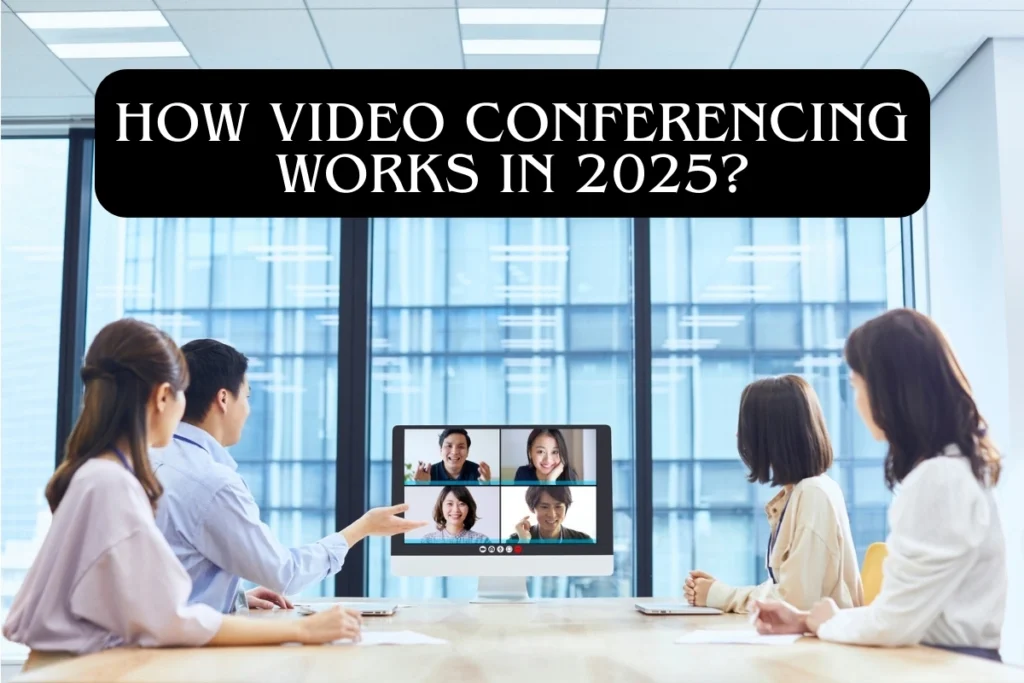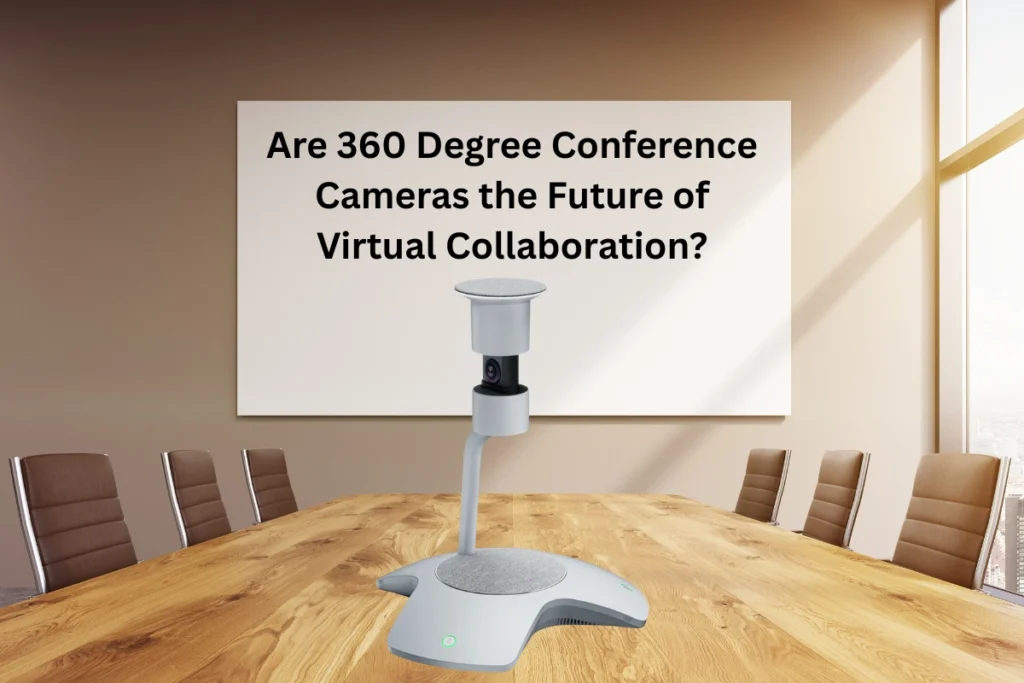Do you remember those times when “attending a meeting” simply meant commuting, rushing through traffic, and sitting and waiting in the room like for hours with a questionable coffee? Fast forward to today’s style, and a laptop, a webcam, and an internet connection can put you in the same room with anyone, and anywhere.
Now, welcome to the age of video conferencing, but what exactly is it, how video conferencing works, and why is it now considered very important to how we work and communicate? Let’s break it down.
What Is Video Conferencing?
Let’s start with what video conferencing is. Well, it’s basically a live visual connection between two or more people residing in completely different locations, via using computer networks to transmit audio and video.
It’s how your boss runs the Monday morning sync, your kid’s teacher hosts a virtual parent-teacher meeting, and probably doctors offer telehealth consultations. Whether you’re working from home or catching up with a remote colleague who lives far away from you, it makes face-to-face interactions possible regardless of the location you are in, without anyone ever leaving their desk or place.
If you want to learn more about the best video conferencing systems available, please visit our website at Spoglink.
How Video Conferencing Works
Next up is how video conferencing works. This concept might sound quite techy for a beginner or non-tech people, but it’s not actually; it’s pretty easy to understand and grasp.
Here’s what happens behind the scenes when you join a video call:
- Audio and video are captured through your device’s microphone and camera.
- This data is compressed and transmitted through the internet using specialized protocols (like WebRTC).
- On the other end, participants receive that data, which is decoded and displayed in real time.
Essential components:
- Hardware: Webcam, microphone, speakers/headphones
- Software: Zoom, Microsoft Teams, Google Meet, or a dedicated platform
- Network: A stable internet connection is critical
- Cloud-based servers: These enable faster processing and scalability
Types of Video Conferencing Systems
Neither are all setups created equal, nor do they serve all purposes equally. Depending on your needs and budget, there are several types of video conferencing systems to choose from:
1. Software-Based Solutions
These include:
- Zoom
- Microsoft Teams
- Google Meet
They are cost-effective and require minimal hardware support; besides that, they are also a perfect choice for small teams or remote freelancers.
2. Hardware-Based Systems
Think of:
- Yealink MeetingBars
- All-in-one kits with built-in speakers, cameras, and AI-based tracking
- Room-based conference systems
Perfect match for large meeting rooms or hybrid offices where quality and reliability are critical.
3. All-in-One Video Conferencing Systems
Devices like the Yealink MeetingBar A20 or A40 combine camera, microphone, and speakers in one smooth unit, making them perfect for messy rooms and executive offices. Explore more MeetingBars options at Spoglink.
Uses for Video Conferencing
From casual check-ins to international summits, video conferencing fits nearly every communication need. Here’s how it’s used in real-world scenarios:
| Industry | Use Case |
| Business | Virtual meetings, remote hiring, webinars |
| Education | Online classes, virtual tutoring |
| Healthcare | Telemedicine, remote diagnoses |
| Customer Support | Live help desk, onboarding |
| Legal & Government | Remote trials, public forums |
Video conferencing isn’t just convenient, it’s essential. Check our blog for more details on What’s the Best Video Conferencing System in 2025?
Pros and Cons of Video Conferencing
Like any tool, video conferencing has its ups and downs.
Pros
- Saves time & cost: No travel needed.
- Boosts collaboration: Screen sharing, chat, breakout rooms.
- Flexible & scalable: From one-on-ones to webinars.
Cons
- Tech issues: Lag, drops, or poor connectivity.
- Fatigue: “Zoom fatigue” is real.
- Security concerns: Encryption and access control are key.
Choosing the Right Video Conferencing System
Before you buy a device or sign up for a platform, consider these key factors:
| Factor | Why It Matters |
| Room size | Larger rooms need higher-end audio/video coverage |
| Participant count | Bigger teams require more robust solutions |
| Internet quality | Some systems are optimized for low bandwidth |
| Compatibility | Works with Teams, Zoom, Google Meet? |
| Budget | Prices range from $100 to $3000+ |
If you’re outfitting a conference room, an all-in-one device like the Yealink MeetingBar A40 is a reliable choice.
Why All-in-One Systems Are Gaining Popularity
Businesses these days want a very simple, reliable, and superb design setup, and that’s where all-in-one systems rock and roll. No messy cables, no multiple devices, just plug-and-play collaborations.
Yealink’s MeetingBars, for instance, come with:
- 4K AI camera with auto-framing.
- Noise-proof microphones.
- Native integration with Zoom and Microsoft Teams.
You get boardroom-quality meetings, even in small occupied spaces.
Why Hybrid Work Needs Smarter Video Conferencing Than Ever
The rise of hybrid work models, where employees split their time between the office and home, has drastically accelerated the evolution of video conferencing technology. Employers are now investing in smarter systems that ensure seamless communication, regardless of physical location. Features like AI speaker tracking, auto-framing, and background noise suppression are no longer “nice to have”; they’re essential.
Companies are also prioritizing interoperability, choosing systems that support Zoom, Microsoft Teams, and Google Meet natively. This ensures every participant, whether joining from a home office or a conference room, experiences the same clarity and engagement. Devices like the Yealink MeetingBar A50 are built for such flexibility, offering plug-and-play simplicity with enterprise-grade reliability.
Want to know more about our products and how to set them up? Don’t hesitate to reach out to us via our Contact Us page.
Future Trends: Where Is Video Conferencing Headed?
We’ve come a long way from inferior quality Skype calls and frozen faces, and lagging networks. The future of video conferencing is bent more heavily into AI-driven improved versions, augmented reality (AR), and immersive collaboration environments. Expect to see more virtual whiteboards, real-time translation features, and eye-contact correction, designed to close the gap between virtual and in-person interactions.
For IT teams and business owners, this means staying up-to-date with scalable, secure, and future-proof systems. Cloud-native platforms combined with all-in-one hardware are paving the way for smarter, more intuitive virtual meetings. As businesses grow and adapt, so must the tech they rely on to stay connected.
Final Point: Let’s Face It, Now Video Conferencing Is Here to Stay
Whether you’re working remotely, running a business, or attending virtual classes, video conferencing is now a core part of modern communication and needs. And understanding how it works helps you choose the right solution and get the most out of every call.

Spoglink: Where Smart Buyers Go for Smarter Gear
Join thousands who rely on us for quality, performance, and real support.





